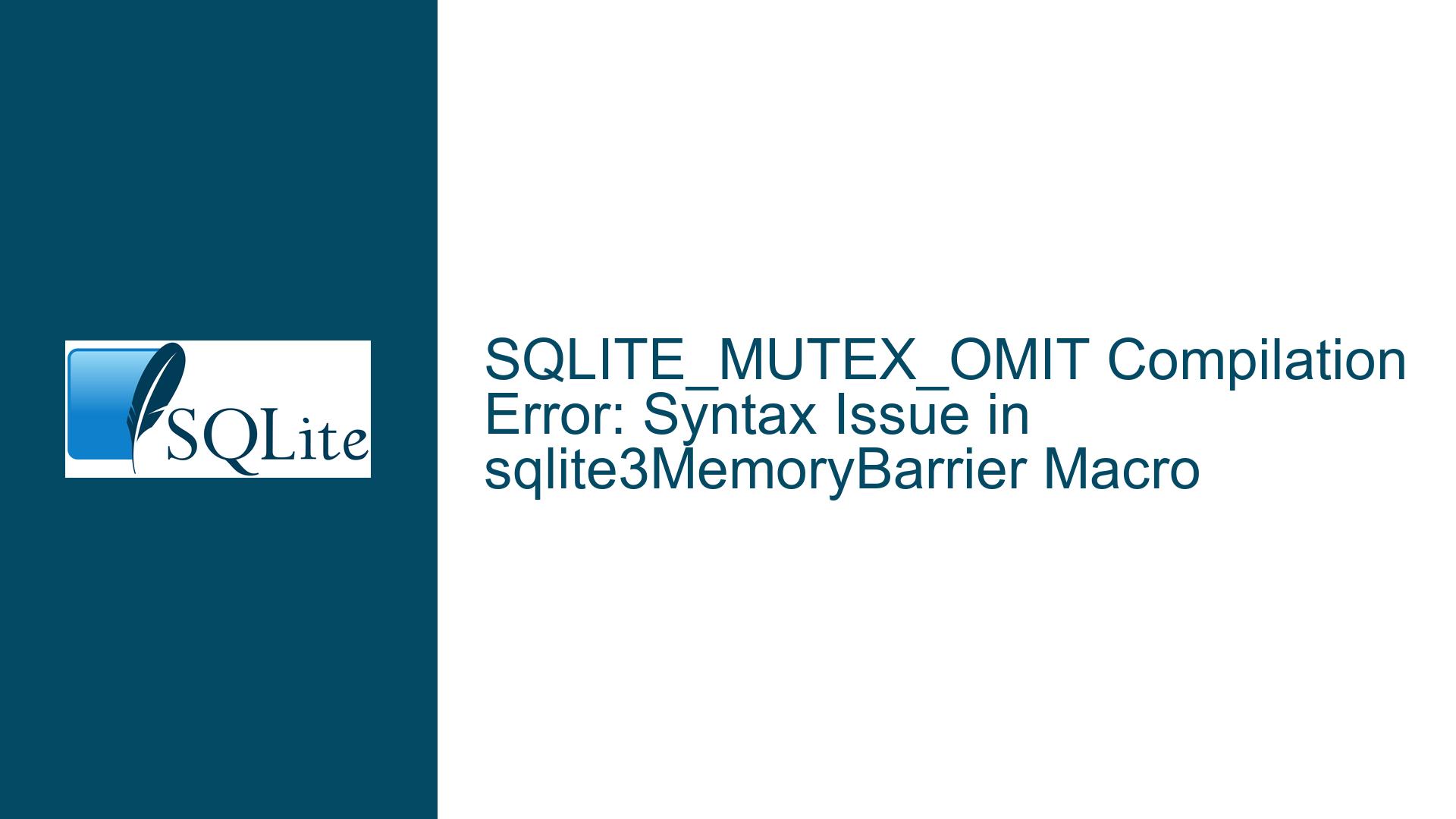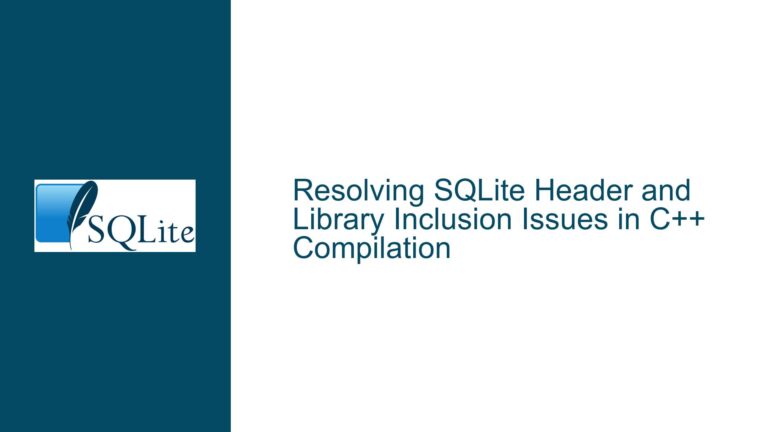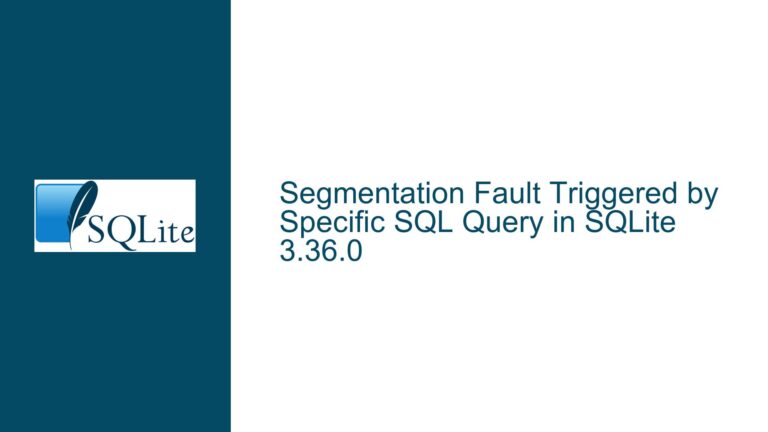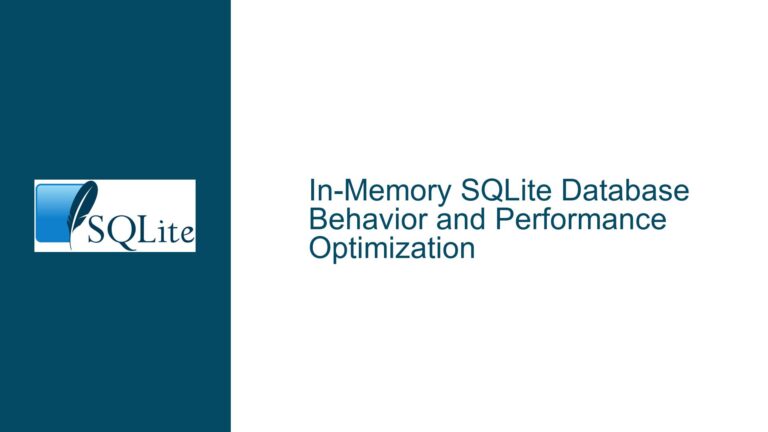SQLITE_MUTEX_OMIT Compilation Error: Syntax Issue in sqlite3MemoryBarrier Macro
Understanding SQLITE_MUTEX_OMIT and Its Role in SQLite Compilation
SQLite is a lightweight, embedded SQL database engine that is widely used due to its simplicity, efficiency, and portability. One of the key features of SQLite is its configurability, which allows developers to tailor the database engine to their specific needs by enabling or disabling certain features at compile time. Among these configuration options is SQLITE_MUTEX_OMIT, a preprocessor macro that is designed to omit the mutex (mutual exclusion) subsystem entirely from the compiled SQLite library. This can be particularly useful in environments where threading is not a concern, or where the application itself handles all synchronization, thereby potentially reducing the size of the compiled binary and improving performance.
However, as highlighted in the discussion, attempting to define SQLITE_MUTEX_OMIT during compilation can lead to a syntax error, specifically in the sqlite3MemoryBarrier macro. This error occurs at line 28475 of the amalgamated source file, which is a single, large source file generated by combining all the individual source files of SQLite into one. The amalgamated source file is often used for simplicity and ease of integration into larger projects, but it can also introduce complexities when dealing with certain compile-time configurations.
The error message indicates that the number of parameters for the sqlite3MemoryBarrier macro does not match what is expected. This suggests that the macro is being used in a way that is incompatible with the SQLITE_MUTEX_OMIT configuration. To understand why this happens, it is important to delve into the relationship between SQLITE_MUTEX_OMIT, the sqlite3MemoryBarrier macro, and the overall SQLite compilation process.
The sqlite3MemoryBarrier macro is a low-level synchronization primitive used to prevent the compiler and CPU from reordering memory operations across the barrier. This is crucial for ensuring correct behavior in multi-threaded environments, where the order of memory accesses can affect the correctness of the program. When SQLITE_MUTEX_OMIT is defined, the expectation is that the mutex subsystem, which relies on memory barriers for correct operation, is not needed. However, the presence of the sqlite3MemoryBarrier macro in the code suggests that there are still parts of SQLite that depend on memory barriers, even when mutexes are omitted.
This discrepancy between the expected behavior when SQLITE_MUTEX_OMIT is defined and the actual code that is compiled is the root cause of the syntax error. The sqlite3MemoryBarrier macro is likely defined in a way that assumes the presence of the mutex subsystem, and when that subsystem is omitted, the macro’s definition becomes invalid, leading to the compilation error.
In contrast, using SQLITE_MUTEX_NOOP instead of SQLITE_MUTEX_OMIT allows the compilation to proceed without errors. SQLITE_MUTEX_NOOP is a configuration option that replaces the mutex subsystem with a no-operation (no-op) implementation. This means that the mutex functions are still present in the compiled binary, but they do not perform any actual synchronization. This approach avoids the syntax error because the sqlite3MemoryBarrier macro remains valid, even though the mutex subsystem is effectively disabled.
However, as noted in the discussion, using SQLITE_MUTEX_NOOP does not result in a significant speed or size impact compared to the default configuration. This is because the no-op implementation still includes the overhead of the mutex function calls, even though they do not perform any meaningful work. This lack of significant improvement in performance or binary size may lead developers to question whether the effort of configuring SQLite in this way is worthwhile.
To fully understand the implications of using SQLITE_MUTEX_OMIT versus SQLITE_MUTEX_NOOP, it is necessary to explore the underlying causes of the compilation error and the potential solutions. This requires a detailed examination of the SQLite source code, the role of memory barriers in synchronization, and the impact of different configuration options on the compiled binary.
Exploring the Causes of the SQLITE_MUTEX_OMIT Compilation Error
The compilation error encountered when defining SQLITE_MUTEX_OMIT is a direct result of the interaction between the sqlite3MemoryBarrier macro and the mutex subsystem in SQLite. To understand why this error occurs, it is necessary to examine the source code of SQLite, particularly the parts that deal with memory barriers and mutexes.
The sqlite3MemoryBarrier macro is defined in the SQLite source code as part of the low-level synchronization primitives. Its purpose is to ensure that memory operations are not reordered across the barrier, which is essential for correct behavior in multi-threaded environments. The macro is typically implemented using platform-specific intrinsics or assembly code, depending on the target architecture. For example, on x86 architectures, the mfence instruction might be used to enforce a memory barrier.
When SQLITE_MUTEX_OMIT is defined, the expectation is that the mutex subsystem is not needed, and therefore, any code that depends on mutexes can be omitted. However, the sqlite3MemoryBarrier macro is not part of the mutex subsystem itself; rather, it is a low-level primitive that is used by the mutex subsystem and other parts of SQLite that require synchronization. As a result, even when SQLITE_MUTEX_OMIT is defined, the sqlite3MemoryBarrier macro is still required by other parts of the code.
The problem arises because the definition of the sqlite3MemoryBarrier macro assumes the presence of the mutex subsystem. Specifically, the macro may be defined in a way that references mutex-related data structures or functions. When SQLITE_MUTEX_OMIT is defined, these references become invalid, leading to a syntax error during compilation.
For example, consider the following hypothetical definition of the sqlite3MemoryBarrier macro:
#define sqlite3MemoryBarrier() \
do { \
if (sqlite3GlobalConfig.mutex.xMutexAlloc != NULL) { \
sqlite3GlobalConfig.mutex.xMutexAlloc(); \
} \
__sync_synchronize(); \
} while (0)
In this example, the macro checks whether the mutex allocation function is defined in the global configuration structure (sqlite3GlobalConfig.mutex.xMutexAlloc). If it is, the macro calls the function before executing the memory barrier instruction (__sync_synchronize()). When SQLITE_MUTEX_OMIT is defined, the sqlite3GlobalConfig.mutex structure is not defined, leading to a syntax error when the macro is expanded.
This example illustrates how the sqlite3MemoryBarrier macro can depend on the mutex subsystem, even though it is not part of the subsystem itself. When SQLITE_MUTEX_OMIT is defined, this dependency becomes a problem, resulting in a compilation error.
In contrast, when SQLITE_MUTEX_NOOP is defined, the mutex subsystem is replaced with a no-op implementation. This means that the mutex-related data structures and functions are still present, but they do not perform any actual synchronization. As a result, the sqlite3MemoryBarrier macro remains valid, and the compilation proceeds without errors.
However, as noted in the discussion, using SQLITE_MUTEX_NOOP does not result in a significant speed or size impact compared to the default configuration. This is because the no-op implementation still includes the overhead of the mutex function calls, even though they do not perform any meaningful work. This lack of significant improvement in performance or binary size may lead developers to question whether the effort of configuring SQLite in this way is worthwhile.
To address the compilation error and achieve the desired performance and size improvements, it is necessary to explore alternative approaches to configuring SQLite. This may involve modifying the source code to remove the dependency on the mutex subsystem in the sqlite3MemoryBarrier macro, or using a different configuration option that provides the desired benefits without introducing compilation errors.
Resolving the SQLITE_MUTEX_OMIT Compilation Error: Steps and Solutions
To resolve the compilation error encountered when defining SQLITE_MUTEX_OMIT, it is necessary to address the underlying issue with the sqlite3MemoryBarrier macro. This can be achieved through a combination of code modifications and alternative configuration options. The following steps outline the process of troubleshooting and resolving the issue:
Step 1: Analyze the sqlite3MemoryBarrier Macro Definition
The first step in resolving the compilation error is to analyze the definition of the sqlite3MemoryBarrier macro in the SQLite source code. This involves locating the macro definition in the amalgamated source file and examining its implementation. The goal is to identify any dependencies on the mutex subsystem that may be causing the syntax error when SQLITE_MUTEX_OMIT is defined.
For example, if the macro references mutex-related data structures or functions, these references should be removed or replaced with alternative implementations that do not depend on the mutex subsystem. This may involve modifying the macro definition to use platform-specific memory barrier instructions directly, without any additional checks or function calls.
Step 2: Modify the sqlite3MemoryBarrier Macro to Remove Mutex Dependencies
Once the dependencies on the mutex subsystem have been identified, the next step is to modify the sqlite3MemoryBarrier macro to remove these dependencies. This may involve rewriting the macro to use a simpler implementation that does not rely on mutex-related data structures or functions.
For example, the modified macro might look like this:
#define sqlite3MemoryBarrier() __sync_synchronize()
In this example, the macro is simplified to directly invoke the __sync_synchronize() intrinsic, which is a common memory barrier instruction on many platforms. This removes the dependency on the mutex subsystem and ensures that the macro remains valid even when SQLITE_MUTEX_OMIT is defined.
Step 3: Test the Modified SQLite Source Code
After modifying the sqlite3MemoryBarrier macro, the next step is to test the modified SQLite source code to ensure that it compiles correctly and functions as expected. This involves recompiling the SQLite library with SQLITE_MUTEX_OMIT defined and running a series of tests to verify that the memory barrier functionality is working correctly.
If the compilation succeeds and the tests pass, the modification is considered successful. However, if any issues are encountered, further analysis and debugging may be required to identify and resolve the problem.
Step 4: Consider Alternative Configuration Options
If modifying the sqlite3MemoryBarrier macro is not feasible or does not provide the desired performance and size improvements, it may be necessary to consider alternative configuration options. One such option is to use SQLITE_MUTEX_NOOP instead of SQLITE_MUTEX_OMIT. As noted in the discussion, this option allows the compilation to proceed without errors, although it does not provide significant speed or size improvements.
Another option is to explore other SQLite configuration options that may provide the desired benefits without introducing compilation errors. For example, disabling other features or optimizations that are not needed in the target environment may help reduce the size of the compiled binary and improve performance.
Step 5: Evaluate the Impact of Configuration Changes
Finally, it is important to evaluate the impact of any configuration changes on the performance and size of the compiled SQLite library. This involves measuring the size of the binary and running performance benchmarks to determine whether the changes have achieved the desired results.
If the changes do not provide the expected benefits, it may be necessary to revisit the configuration options and consider alternative approaches. This may involve further modifications to the SQLite source code, or exploring other lightweight database solutions that better meet the requirements of the target environment.
In conclusion, the compilation error encountered when defining SQLITE_MUTEX_OMIT is a result of the interaction between the sqlite3MemoryBarrier macro and the mutex subsystem in SQLite. By analyzing the macro definition, modifying it to remove dependencies on the mutex subsystem, and testing the modified code, it is possible to resolve the error and achieve the desired performance and size improvements. However, if these steps do not provide the expected benefits, it may be necessary to consider alternative configuration options or explore other lightweight database solutions.






